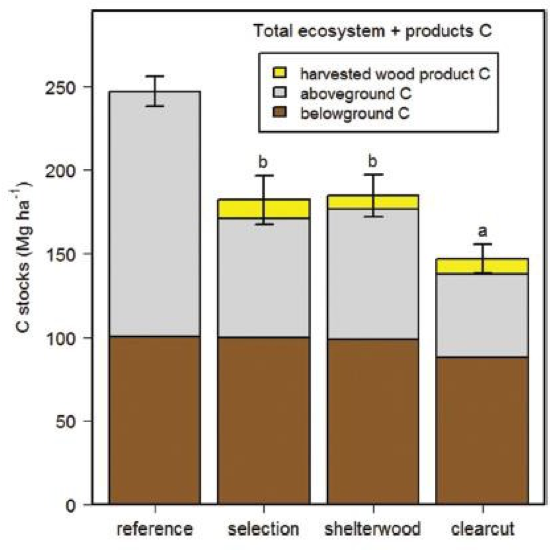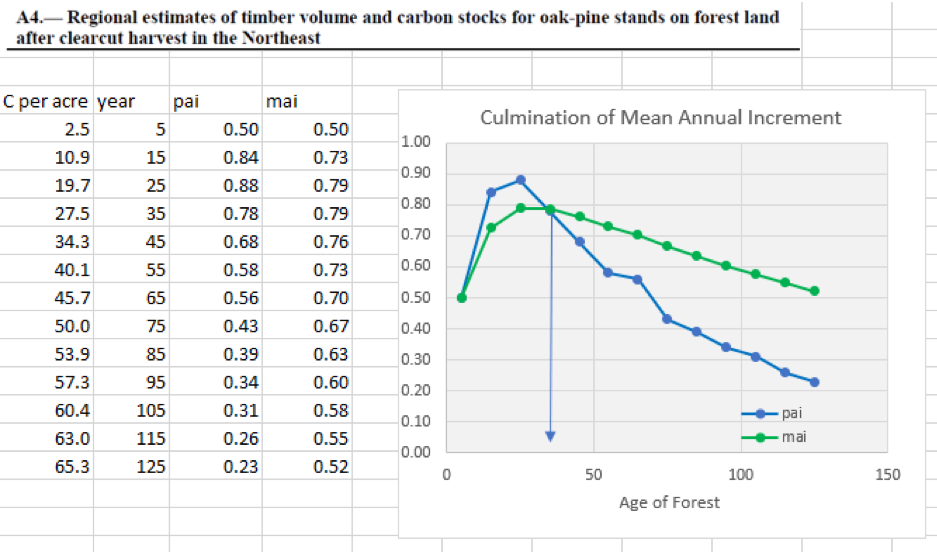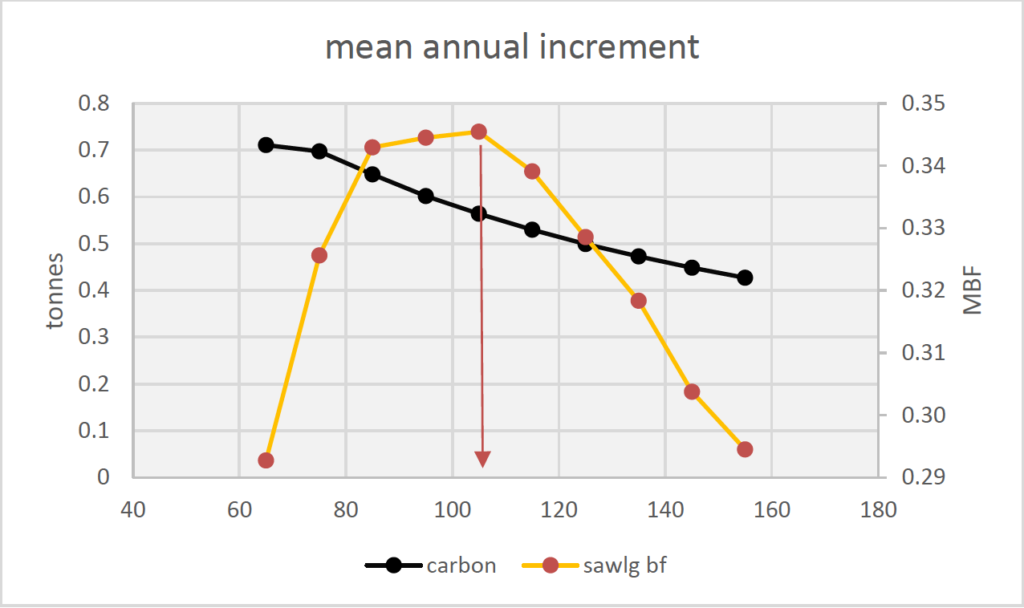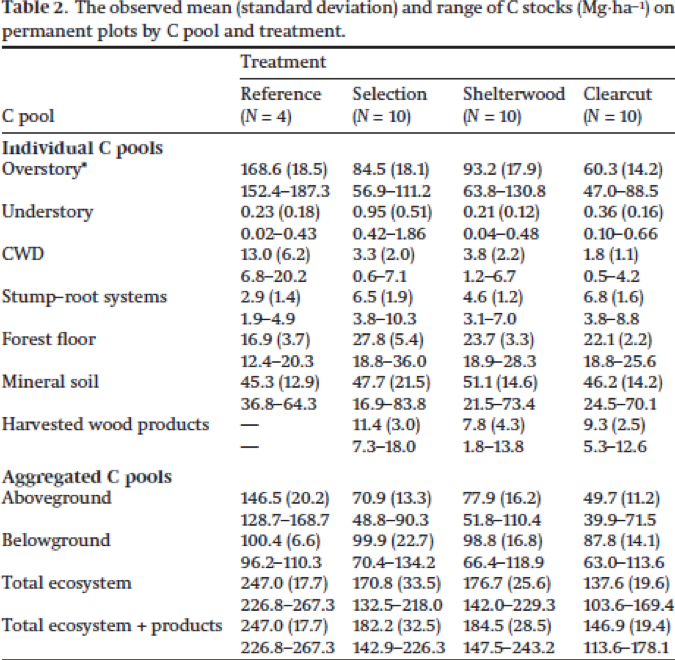By Denny Gallaudet – March 2020
I have the good fortune to be the owner of a 25 acre woodland in Southern Maine. Abandoned as a pasture in the late 1930’s, it is now a flourishing and well stocked forest of the oak-pine variety. In 2016 I conducted a timber inventory and found that carbon stored in live trees was approximately 44 tonnes per acre or 162 MTCO2e. The average or common practice for my area is 76 MTCO2e.
Improved forest management is increasingly thought of as an important climate solution. Currently in Maine the forest in total is sequestering approximately 12 million MTCO2 or close to 75 percent of Maine’s total annual CO2 emissions.
What follows is a discussion of best management practices(“BMPs”) for maximizing carbon sequestration, with specific reference to my woodland.

Based on studies by the University of Maine1, it seems reasonably safe to conclude that the let-it-grow or proforestration approach achieves the best result in Southern Maine. The adjacent graph highlights the results of a careful study of the Penobscot Experimental Forest near Bangor, ME over a 60 year period of forest management. As can be seen, the reference or proforestration approach sequestered close to 40% more carbon than the selection or shelterwood methods and close to 70% more than clear-cut. The lion’s share of the difference is in the resulting overstory – defined as above and below ground portions of live trees and shrubs. While some of the carbon removed in harvests was stored in long lived wood products such as boards, this storage was a small fraction of the carbon released to the atmosphere as a result of harvest removals.
The authors are careful to point out the limitations of this study. The treatment sample sizes are small and the forest type is specific to the Acadian Forest, a transitional zone between the eastern North American broadleaf and boreal forests. Further it does not address the problem of leakage, whereby the carbon withheld from the wood products market by the proforestration approach would be made up by stepped up production on other woodlands. For this reason, forest carbon projects factor in a buffer for leakage, often in the range of 20%. Even with a buffer of this magnitude, the proforestration approach would still maximize carbon sequestration in comparison to other approaches.
However, like many landowners, I have a joint goal of maximizing carbon sequestration in tandem with modest, periodic harvests for wood products and firewood for home use. In this situation what might be best management practices?
As a first step, let us consider the growth and yield profile of an oak-pine forest in the Northeast.2

The culmination of mean annual increment is where a given forest is adding volume and thus carbon at its maximum annual rate. It is the intersection between the mean annual increment (MAI) and the periodic annual increment (PAI). In this data series the period is a decade. For an oak-pine forest like mine, the culmination point is 38 years.
In other words, to maximize carbon sequestration per year a mixed-age forest should be relatively young with a carbon stocking in the range of 30 tonnes per acre. As the average age/stocking grows , the annual rate slows down but is still sequestering carbon at the PAI rate of 0.23 tonnes per year at an average age of 125. As mentioned, the carbon stocking level of my woodland is 44 tonnes per acre so is a bit past its prime at an implied average of around 65 years.
This conclusion was confirmed in an e-mail exchange with Anthony D’Amato3, Professor at the Rubinstein School of Environment and Natural Resources University of Vermont. He wrote “if you were only focused on maximizing sequestration, you would manage for that age range.”
As a second step, let us further consider my parallel goal of periodic harvests of wood products. While wood volume and stored carbon increase in tandem, the value of a harvest is also a function of the board feet of saw logs that can be realized.
For an estimate of the growth and yield of saw logs, I entered the 2016 inventory data into the Forest Vegetation Simulator tool maintained and available from the U.S. Forest Service. As shown in the graph below the culmination MAI for saw logs is around 105 years – almost 70 years older than for carbon.

From a dollar and cents point of view, this extra saw log growth is very material. In 2016 my saw log inventory had an estimated value of about $3,100 per acre. Per the FVS results, letting it grow the extra 40 years to the culmination MAI and assuming the same wood prices would more than double the value per acre to around $6,500 per acre.
Like most woodlands, the economic value resides in the saw logs – in my case around 85% and predominantly white pine and red oak.
Thus, the goal of maximizing carbon sequestration Is in conflict with the goal of maximizing the value of wood products. They are not mutually exclusive however. As my woodland matures towards the culmination MAI for saw logs, it is still sequestering carbon albeit at a slower rate than a younger woodland. My management plan is therefore to target the 100 average age range with a goal of steadily improving the timber quality over the years.
Also from a carbon sequestration perspective, the higher the yield in saw logs from a given harvest the higher the amount of carbon stored in long-lived wood products such as boards, building materials and the like.
Turning now to silviculture, what observations can be made about BMPs to maximize carbon sequestration.
As mentioned and shown in more detail in this table from the Puhlick article, the preponderance of the carbon is sequestered in the overstory. Further, as between the reference/proforestration and the active management treatments, the difference in total ecosystem carbon is almost entirely explained by differences in the overstory.

Committed as I have been to low impact forestry, I find this a somewhat surprising result. For my own work, I use a chainsaw and a skidding winch on a small rubber-tired tractor. I am careful not to disturb the soil or the litter on the forest floor. I leave the slash in brush piles as I go. These are common sense approaches and surely make a difference at the margin, but the big driver in carbon appears to be the growth in the overstory. The above study indicates that most of the harvesting was done with chain saws and rubber tired skidders with some horse logging; these are relatively low impact systems compared to the whole tree systems in use presently. Further study would seem to be needed to control for differences between low and high impact forestry.
Lastly, what should be the role of thinning cuts as a companion to removals for high value saw logs? Certainly, thinning is shown to improve overstory growth and enhance the quality of the remaining stand. Such thinning however produces very little revenue for the land owner and sequesters carbon not at all in the case of biomass and only for a short period in the case of pulpwood. In my woodland, I thin for quality by girdling the tree. Standing dead trees retain carbon until they fall and also provide ecosystem services. Once on the ground, the retained carbon is released over time but with a half-life of up to 70 years.4
In summary, proforestration would appear the best approach to maximizing carbon sequestration in Southern Maine. For landowners like myself who seek to maximize carbon sequestration in tandem with harvesting high quality timber, the following BMPs might be indicated:
- Manage toward the culmination MAI of saw logs if longer than that of carbon
- Continue with low impact forestry to protect carbon sequestration in the forest floor and soil
- Leave slash behind to retain carbon and provide compost rather than removing it for biomass, a low value product for the landowner in any case
- Consider thinning by girdling trees and leaving them to age out as standing dead.
1 Puhlick, J et al 2016 Long-term influence of alterative forest management treatments on total ecosystem and wood product carbon storage. NRC Research Press
2 Smith, J et al (2005) Methods for Calculating Forest Ecosystem and Harvested Carbon with Standard Estimates for Forest Types of the United States USDA
3 D’Amato, A and Catanzaro, P (2019) Forest Carbon Amherst MA: University of Massachusetts
4 Achterman,G et al (2006) Forests, Carbon and Climate Change Portland OR: Oregon Forest Resources Institute
